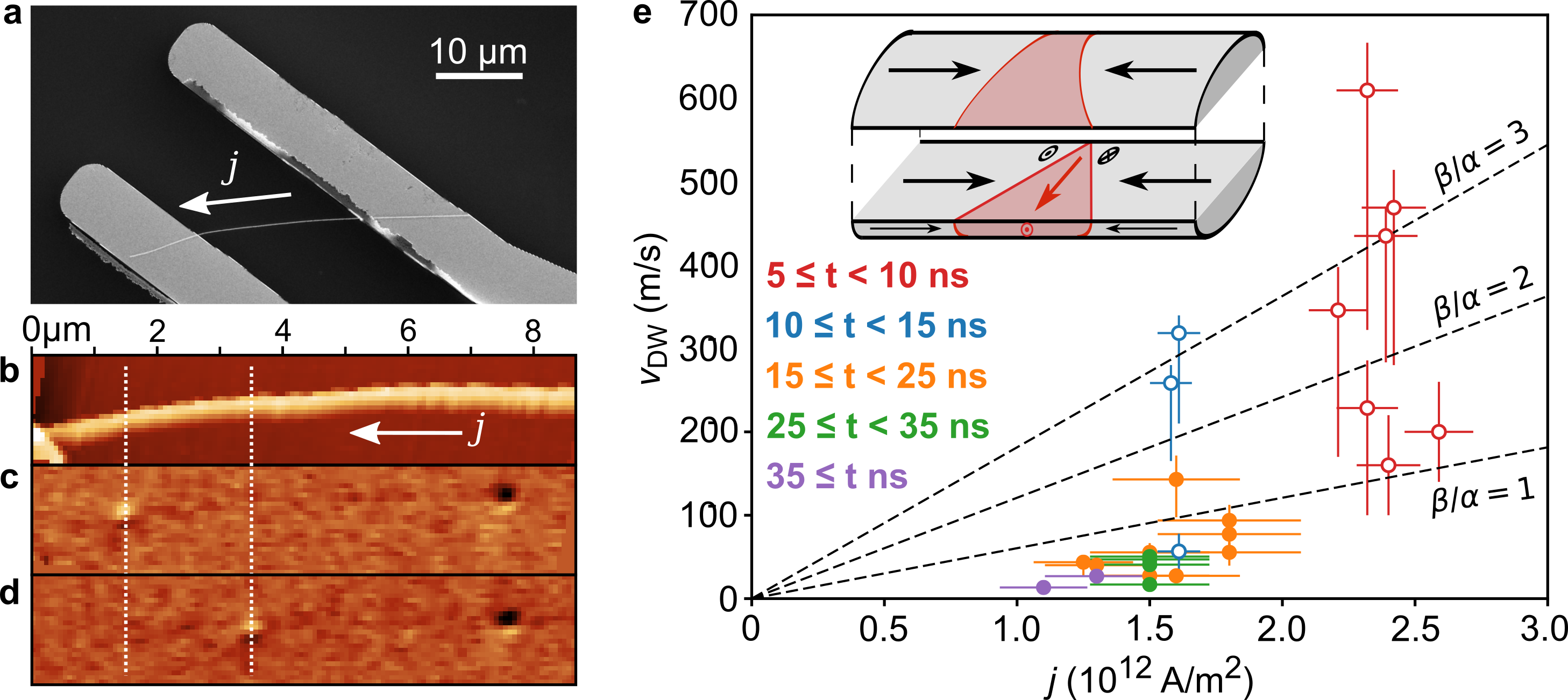Domain-wall motion in one-dimensional conduits is both a textbook case for magnetization dynamics and the understanding of spin torques, and of practical importance for the design of novel spintronic ICT devices. However, instabilities known as Walker breakdown limit the speed in most cases. We have shown experimentally and confirmed by simulation, that these instabilities are circumvented in cylindrical nanowires, under the combined effects of the Œrsted field and the specific topology of their walls.

(a) Contacted nanowire. (b-d) AFM topography, and MFM monitoring of domain wall motion under current in the wire displayed in a. Schematic open view of a Bloch-point domain wall, and experimental determination of its speed versus electric current strength and duration. Lines are guide to the eye following the simple one-dimension motion of domain walls.
During domain wall motion, the core of walls tend to enter a precessional motion under the stimulus of either external magnetic field or spin-transfer torques. While this is counterbalanced by internal torques (exchange, dipolar etc.) under moderate stimulus, no balance is possible above a given threshold. This induces a drop of the wall mobility called the Walker breakdown, associated with a stochastic behavior. For more than a decade, numerous theoretical reports predicted that the Walker breakdown is suppressed in cylindrical conduits, due to a specific topology of the domain walls, called Bloch-point walls. However, disappointedly, a recent report of ours suggests that this may not be the case for walls moved under magnetic field.
Following this, we developed a specific clean-room process to contact electrically chemically-synthesized cylindrical nanowires with a low contact resistance, presently Co30Ni70 with diameter 90 nm. This allowed us to conduct the first experiments of purely current-induced wall motion in cylindrical nanowires, with a few nanosecond time scale, monitored by both XMCD-PEEM and magnetic force microscopy. We evidenced that Bloch-point walls are robustly stabilized by the Œrsted field arising from the charge current, contrasting with the instability we reported earlier under magnetic field. This comes with wall speed in excess of 500 m/s under current density circa 2×1012 A/m2, a five-fold increase compared with all other cases of direct spin-transfer-torque wall motion of large-magnetization ferromagnets such as 3d elements. These results are reproduced quantitatively by simulations, which confirms the unique absence of Walker breakdown in this cylindrical geometry.
These results illustrate the use that can be made of three-dimensional magnetization textures and their specific topology, a topic of rising interest in the broader context of three-dimensional and curvilinear magnetism. We expect that this first experimental report motivates further work to seek confirmation of the many theoretical predictions of wall motion in cylindrical nanowires. In particular, we are now not far from the 1 km/s limit, at which speed a strong coupling is expected between domain walls and spin waves, and called the magnonic regime.
Teams: Spin textures, Theory and simulation
Collaboration: Institut Néel, Univ. Erlangen Nürnberg, Synchrotrons Elettra and Alba.
Funding: EU M3d, ANR JCJC Matemac 3D.
Further reading: Fast domain walls governed by OErsted fields in cylindrical magnetic nanowires, M. Schöbitz, A. de Riz, S. Martin, S. Bochmann, C. Thirion, J. Vogel, M. Foerster, L. Aballe, T. O. Menteş, A. Locatelli, F. Genuzio, S. Le Denmat, L. Cagnon, J. C. Toussaint, D. Gusakova, J. Bachmann, Olivier Fruchart, Phys. Rev. Lett. 123, 217201 (2019) [arXiv].




